I just happened to be looking at the August 1975 issue of Galaxy Magazine when my attention was caught by an essay: Jim Baen’s “The Myth of the Light-Barrier.” Was this yet another example of what we will polite call “relativity skepticism,” perhaps an early look at Petr Beckmann’s Galilean Electrodynamics? In short, no. Instead Baen celebrated the fact that a rocket capable of sustaining a one-gravity acceleration indefinitely can travel astonishing distances in a very short time from the perspective of the traveler. Of course, the stay-at-home will experience a lot more time, but Baen sees this as a plus:
And that’s the point. Given a one-gravity, constant-acceleration space-vehicle plus a complete indifference to point of origin, you can go anywhere and do anything. You can even be free. Because anybody who might have an inclination to tamper with your liberty (unless you were foolish enough to bring him along) will have been dust long before you arrive at your destination. Blue meanies included. Freedom!
This is entirely true. See the chart below (lifted without credit from a 2018 Tor.com essay by someone or other) for distances covered at one gee.
| Destination | Distance (Light Years) | Ship Time (Years) | Earth Time (Years) |
| Alpha Centauri | 4.3 | 3.6 | 5.9 |
| Tau Ceti | 11.9 | 5.1 | 13.7 |
| 40 Eridani | 16.3 | 5.7 | 18.1 |
| The Pleiades | 444 | 11.9 | 446 |
| Crab Nebula | 6,500 | 17.1 | ~6,500 |
| Galactic Core | 28,000 | 19.9 | ~28,000 |
| Andromeda Galaxy | 2,500,000 | 28.6 | ~2,500,000 |
Thanks to inconsiderate details like engineering practicalities, the rocket equation, and the irritating fact that Bussard ramjets are nine orders of magnitude more efficient at dissipating energy than they are at generating it, this table is completely irrelevant to any future that humans are likely to experience. However, just because something is impractical or even impossible has never stopped SF authors from exploring a cool idea in their fiction.
“A Momentary Taste of Being” by James Tiptree, Jr. (1975)
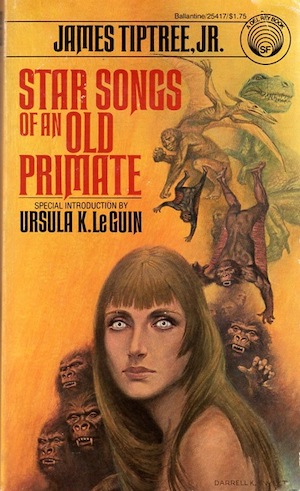
Four light-years from overcrowded Earth, the Centaurus searches for a world suitable for colonization. Thus far, there has been no good news for Earth’s tens of billions. Now a promising world presents itself…but is the seemingly perfect world a trap?
Not being an idiot, the captain of the Centaurus dispatches a survey team to examine the world. Only Lory Kaye returns, bringing with her samples from the world below. Is the planet the paradise Lory claims? Or is there some darker reason why the rest of the survey team did not return?
Some readers may turn to science fiction for the reassurance and solace they do not find in life. To these readers I say, “under no circumstances use Tiptree’s fiction for this purpose.” At least this story is more upbeat than The Screwfly Solution.
“Rammer” by Larry Niven (1971)
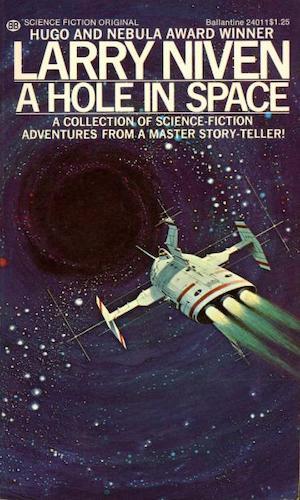
Jerome Corbett gambled that he could elude terminal illness by undergoing suspended animation. He lost the bet. Freezing caused irreversible cell damage. Corbett was as dead as dead could be…but his memories could be salvaged. The state of 2190 had a use for those.
Corbett’s memories were imprinted into the brain of a convicted criminal. Corbett was a loner and so is the new composite. This makes him a perfect candidate for piloting Bussard ramjets on one-way missions to tomorrow. Many people might balk at such a task. Corbett takes it much farther than his masters intended.
It’s possible this story inspired the Baen editorial, because the eventual resolution hinges on the fact that a round trip to the core of the galaxy and back is fortyish years to Corbett and seventy thousand for the state. Or so Corbett thinks, because it doesn’t occur to him that ramjets may not deliver an ideal performance. A World Out of Time, the novel that grew out of “Rammer,” explores that notion.
Red Lightning by John Varley (2006)
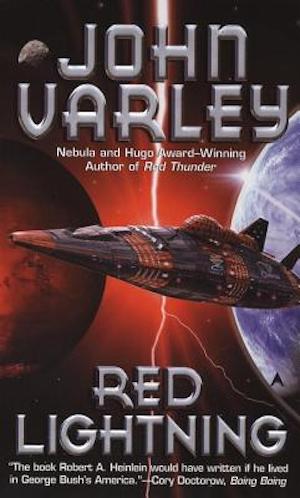
Eccentric inventor Jubal Broussard provided humanity with endless power thanks to Broussard’s super-scientific “squeezer.” The squeezer in turn delivered cheap constant-acceleration space travel (unbounded by mere mass ratios) to the other planets of the Solar System…and for those who wanted it, to the stars as well.
The downside of this arrangement is revealed when malcontents send their starship on a long acceleration loop that will terminate on the Earth’s surface. The resulting impact will be Chicxulub-scale. Terrestrial governments, trapped as they are in a particularly bitter emulation of late-Heinlein cynicism, are poorly equipped to deal with the crisis.
Bussard ramjets, tachyon-emitting rockets, and their ilk would function very nicely as weapons of planetary destruction. See also Charles Stross’ Iron Sunrise. Good thing that they’re impossible.
The Salvage Crew by Yudhanjaya Wijeratne (2020)
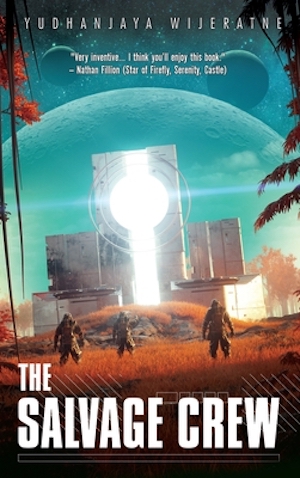
Enabled by inexpensive sub-light star travel, the United Nations (UN) and rival Outer Reaches Colonial Association (ORCA) are in a race to see which of them can be the fastest at spreading humanity and its creations across the nearer stars. It is a time-consuming, expensive contest, one that encourages cost-cutting measures.
Affordably priced Planetary Crusade Services dispatches AI overseer AMBER ROSE 348 and its crew to investigate an ancient crash site. Hired because they were cheap rather than notably competent, AMBER ROSE’s crew finds themselves out of their depth. Not only did they land in the wrong location on an alien world, and not only is said alien world alarmingly well-stocked with apex predators, but ORCA has dispatched its own team to the planet. The heavily armed ORCA cyborgs may not be more competent than AMBER ROSE’s, but they are considerably more violent.
AMBER ROSE is always spelled in all caps, as are all its pronouncements. It seems this future has starships and artificial intelligences of a sort, not to mention an impressive grasp of the Peter Principle, but volume control technology has been lost. That or the poor AI has discovered that the only way to get the full attention of the meat-sacks is to yell at them.
We Are Legion (We Are Bob) by Dennis E. Taylor (2016)
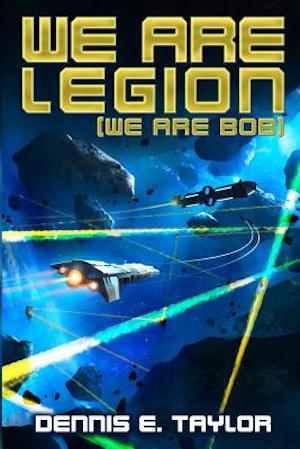
After a close encounter with Truck-kun, Bob Johansson wakes to find himself in much the same situation as Niven’s Jerome Corbett. Bob’s body is long gone. Bob is now an AI, a simulation of the dead man. Bob was created to crew a relativistic starship. Should he fall short of needs, he will be erased.
Complicating matters: the setting is an Earth that is quite, quite ununified. Tensions between the Free American Independent Theocratic Hegemony and Brazil need only a small spark to ignite a catastrophic world war. Bob may be that spark. Unless he can launch safely, Bob is trapped on a world out of time.
The detail that most stood out to me in this novel is that when the multiply-copied Bob finds himself dealing with desperate survivors, Bob does not immediately start muttering “lifeboat rules” while looking for a convenient airlock through which the refugees could be guided. Bob’s equations are at least a little warm.
***
While superluminal star flight is, for obvious reasons, far more popular than sub-light, tales of thrilling adventure enabled by ships capable of ever-growing velocities, ships easily spanning interstellar distances, abound in science fiction. These five works are a very small sample. If your favorites were omitted for some reason, feel free to remind us of them in comments, below.
In the words of fanfiction author Musty181, four-time Hugo finalist, prolific book reviewer, and perennial Darwin Award nominee James Davis Nicoll “looks like a default mii with glasses.” His work has appeared in Interzone, Publishers Weekly and Romantic Times as well as on his own websites, James Nicoll Reviews (where he is assisted by editor Karen Lofstrom and web person Adrienne L. Travis) and the 2021, 2022, and 2023 Aurora Award finalist Young People Read Old SFF (where he is assisted by web person Adrienne L. Travis). His Patreon can be found here.










